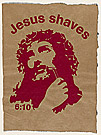Neo-Pop
The new figuration in underground contemporary art known as Pop Surrealism emerged in California in the late 1980s and early 1990s and has since spread around the globe, spawning unique local flavours and styles in each geographic location. In Australia, the local neo‑Pop phase emerged with a transition from modern graffiti forms based in the gestural and the written word to street stencils and posters based on sampled and appropriated pop cultural images and icons. The explosion of new technology over recent decades has fuelled the production of this art form. Ned Kelly, Yoda, science-fiction monsters, subhumans and robots, media celebrities and pop-cultural icons such as Diana and Charles have become the subject matter of artists who have enthusiastically embraced the infiltration of television, computer games, magazines, comics, films and animation and harnessed the disseminating power of the internet, digital photography and quick‑copy scanners and printers.
Stencilling, as one specific form of street art, peaked in Australia in 2004: many of the now iconic Australian street stencils were created during the astonishing influx of neo‑Pop works appearing between 2003 and 2004. The street-stencil images held in Australia’s national art collection were created for the street, where they have long since decayed, been painted over, buffed and destroyed. In 2004, the National Gallery of Australia intervened, asking artists to print their street stencils on paper. Once put to paper, collected, preserved and displayed in a completely different context, these works of art essentially become important documents or records of imagery originally intended for the street. The collection of street stencils at the Gallery—only a portion of which is on display in Space invaders—is now a time capsule of what was happening on Australian streets at a particular moment of collective creativity. It is also potentially the only permanent record of the national stencil phenomenon that peaked around 2003–04.
Zap and I started working together in 2004. It took us a while to find what we both wanted to do with the posters because there was no precedent, there was absolutely nobody doing them, in a way that was more exciting and in a way nobody in Sydney really is still doing it which is good it makes what we do unique. We use a lot of found images and we assemble them in a spontaneous way, I’ll see a body of a villain that I like and put it with the head of another character . . Zap is much the same but he uses different references...that doesn’t matter though,, we are working towards a similar goal, to use images in a cut-up style like Dada where you are free to merge and combine separate forms.
JumboI have been working under the name ZAP since 1996. However my first tag was SHAZAM which came from comic books and that was in 1986, this led to me using the name ZAP. Also what inspired the name ZAP was all the comic speech bubbles which had ZAP in them, and graffiti art from the 70s. The name ZAP made me think of a superhero character which fights bad guys and rains an array of cosmic colours across city walls.
Zap


![SIBLEY, Dan | Colour fun volume 1 [poster]. | 2002](images/sml/159015.jpg)
![SIBLEY, Dan | Dot 2 dot volume 1 [poster]. | 2002](images/sml/159011.jpg)



![NUROK | Not titled [purple nude III]. | 2003](images/sml/153145.jpg)
![NUROK | Not titled [purple nude II]. | 2003](images/sml/153146.jpg)
![PRISM | not titled [red shoes]. | 2004](images/sml/145459.jpg)
![PRISM | Not titled [girl]. | 2004](images/sml/144632.jpg)
![PROOF | Not titled [lightening]. | 2004](images/sml/159012.jpg)
![SYNC | Untitled [yoda]. | 2004](images/sml/153218.jpg)
![SYNC | Not titled [scream]. | 2004](images/sml/158961.jpg)